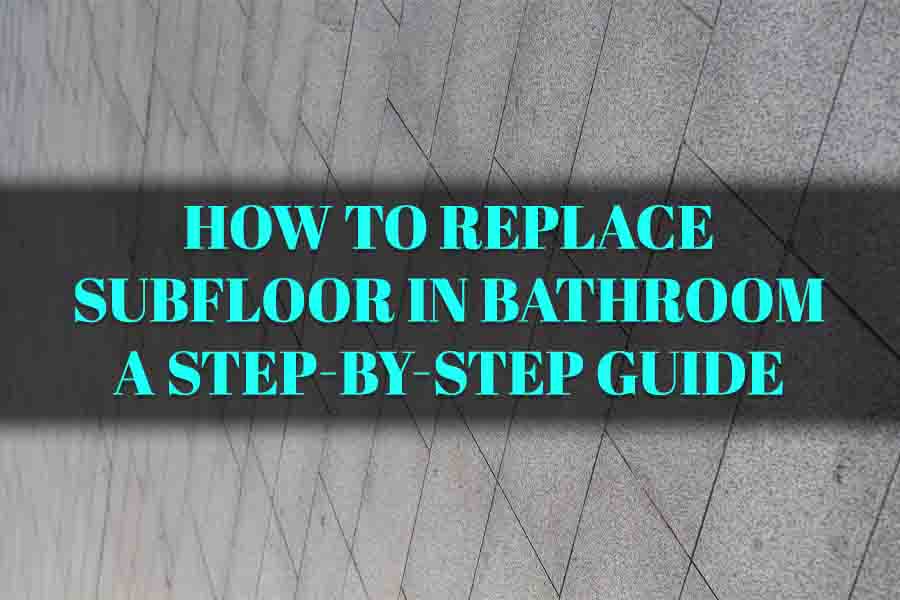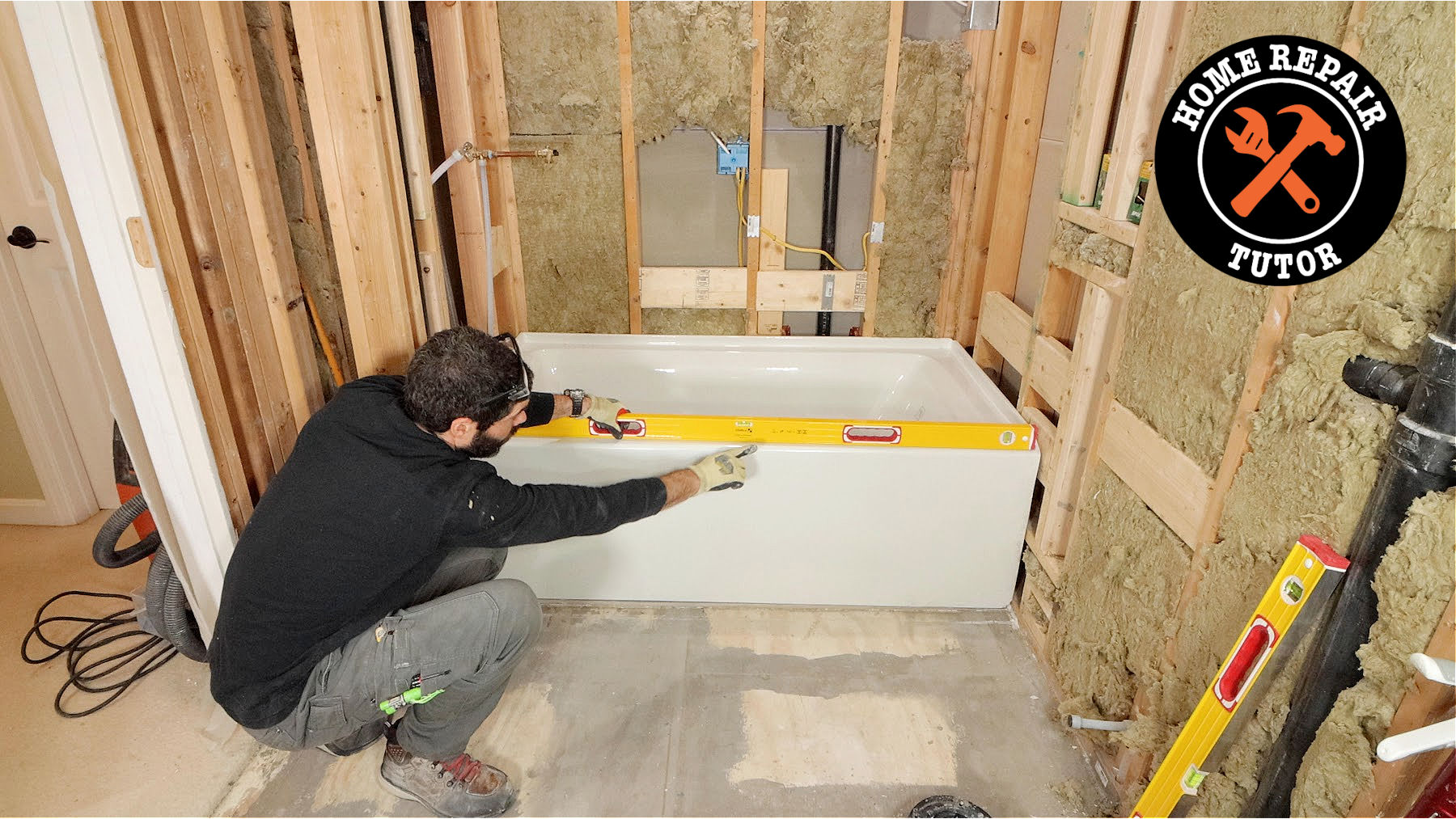
To replace a bathroom subfloor, start by removing the toilet and any fixtures. Next, cut out the damaged subfloor and install a new plywood base.
Replacing a bathroom subfloor is often essential when water damage, mold, or structural weakness is present. This task requires precision and attention to detail to ensure the structural integrity of the bathroom floor and the safety of those using the space.
Undertaking a subfloor replacement involves a systematic approach to remove the old, compromised material and replace it with new, sturdy plywood or equivalent materials that can withstand the bathroom’s damp environment. The job includes adjusting for plumbing fixtures, careful measurements, and securing the new subfloor in a way that prevents future damage. A successful subfloor replacement can drastically extend the life of your bathroom and protect your investment in your home.

Credit: emilioflooringtyler.com
Signs Your Bathroom Subfloor Needs Replacement
Keeping a firm foundation underfoot is crucial for bathroom safety and integrity. It’s essential to spot the signs of a failing subfloor early. Doing so can avoid more extensive and costly repairs. Look out for these telltale indicators:
Visible Water Damage Or Rot
Water is the enemy of wooden subfloors. Frequent exposure leads to damage. Telltale signs include:
- Discolored flooring, often darker than surrounding areas
- Soft spots that may sink under pressure
- Warped or buckled flooring surfaces
Visible rot requires immediate action. Timely replacement prevents structural damage.
Spongy Or Uneven Flooring
Ever step on a bathroom floor that felt less than solid? That’s a red flag:
- Uneven areas may suggest moisture problems
- Floors that “give” under your weight indicate weakness
These symptoms often mean the subfloor has been compromised. Don’t wait – investigate!
Persistent Musty Odors
A musty scent in the bathroom isn’t just unpleasant. It’s a signal:
- Strong, persistent odors point to mold and mildew
- Odors lingering after cleaning suggest hidden issues
Mold thrives on damp subflooring. Replacing affected areas is critical for health and safety.
Stay vigilant for these signs. Early detection can save your bathroom floor from serious damage. Don’t hesitate to seek professional advice if you suspect subfloor troubles.
Preparing For Subfloor Replacement
Preparing for Subfloor Replacement is the first critical step towards a successful bathroom renovation. Ensuring you have all the necessary tools and understand the safety measures involved is essential. Before tearing out the old subfloor, it’s crucial to meticulously plan the removal of fixtures and obstructions. Let’s delve into how you can lay the groundwork for a new and sturdy subfloor.
Tools And Materials You’ll Need
Collecting the right tools and materials before starting will save time and prevent frustration. You’ll need:
- Pry bar to lift the subfloor
- Hammers and nails for securing new material
- Screwdriver to remove screws
- Utility knife for cutting
- Circular saw to cut large sections of the subfloor
- Measuring tape for precise cuts and placement
- Jigsaw or handsaw for tight spaces
- Safety glasses and gloves for protection
- Plywood or OSB for the new subfloor
- Construction adhesive to bond materials
Safety Measures And Precautions
The safety of all involved is paramount. Adhere to the following precautions:
- Wear safety glasses to protect your eyes from debris.
- Use gloves to guard against splinters and nails.
- Turn off electricity in the work area to avoid electrical hazards.
- Keep a first-aid kit close by in case of minor injuries.
- Ensure the work area is well-ventilated, especially if using adhesives.
Removing Fixtures And Obstructions
Clearing the area is a must before you start. Follow these steps:
- Disconnect and remove the toilet.
- Take out the vanity and sink.
- Remove any trim or baseboards.
- Take off the door to make more room for maneuvering.
With these preparations complete, you’re now set to tackle the subfloor replacement with confidence and safety.
Removing The Old Subfloor
The first step in giving your bathroom a fresh start is removing the old subfloor. This process may seem daunting, but with careful execution, you’ll have a clean slate for your new installation. Wear safety gear and proceed with the guidelines below.
Cutting And Lifting Out The Damaged Area
Identify the rot or damage in your subflooring before you begin. You’ll need a circular saw set to the depth of the subfloor. Wear safety glasses and a mask to protect from dust and debris. Make precise cuts around the damaged area.
After cutting, use a pry bar and hammer to lift out the pieces. Be careful not to damage any plumbing or wiring. Place the debris in a heavy-duty trash bag for disposal. Check the area for screws or nails and remove them.
Dealing With Water Damaged Joists
If your joists suffered water damage, they’ll need attention. Assess the damage severity. Minor damage can be sanded and treated with a wood preservative.
For more significant damage, joist repair or replacement is necessary. Consult a professional if you’re unsure about this step. Ensure all repairs are secure and level before proceeding.
Cleaning The Workspace
With the old subfloor gone, remove all remaining debris. This includes dust, wood chips, and any other materials.
- Sweep thoroughly and use a shop-vac for fine particles.
- Check for protruding nails or screws and remove them.
- Ensure the workspace is completely clean before installing the new subfloor.

Credit: homerepairtutor.com
Installing The New Subfloor
Floor integrity is vital in a bathroom. Installing the new subfloor is a key step after removing the old, damaged material. With the right tools and materials, this task ensures a solid, level base for flooring. Let’s dive into the process and provide a durable solution for a bathroom refresh.
Measuring And Cutting The Plywood
Accurate measurements are crucial. Begin by measuring the area to cover with new subflooring. Transfer these dimensions onto your plywood. Use a straight edge to ensure straight lines. Double-check measurements before cutting. Utilize a circular saw for precise cuts. This ensures the plywood fits perfectly in the designated space.
Securing The Subfloor To The Joists
Position the cut plywood in place. Ensure it sits flat and aligns properly with the joists. Use a drill and corrosion-resistant screws for attaching the plywood. Start at the corners and move inward. Ensure screws are placed every 8 inches along the joists. This creates a tight bond between the subfloor and the joists for maximum stability.
Ensuring Level And Support
Check the subfloor for levelness with a carpenter’s level. Look for dips or rises. Adjust as necessary before securing. Confirm that every part of the subfloor has adequate support. Use shims for low areas to prevent flexing. Ensure a firm and level foundation before installing the final flooring. This step is essential for a long-lasting bathroom floor.
Waterproofing And Prevention
Water damage in bathrooms is a homeowners’ nightmare. Proper waterproofing during subfloor replacement is crucial to prevent costly repairs in the future. Learn the steps to select the right materials, apply waterproof membranes, and adopt preventive measures for long-lasting protection.
Choosing The Right Waterproofing Materials
Selecting top-notch waterproofing materials is the first step to safeguard your bathroom subfloor. Here’s what to look for:
- Durability: Pick materials that withstand constant moisture.
- Compatibility: Ensure they work well with your subfloor and tiles.
- Manufacturer’s reputation: Choose products from trusted brands.
- Warranty: Opt for materials with a solid guarantee.
Applying Waterproof Membranes
Once you’ve chosen the materials, the next step is applying a waterproof membrane. Follow these steps:
- Clean the subfloor: Remove debris for a smooth application.
- Apply the primer: Use a roller for an even coat.
- Roll out the membrane: Work in manageable sections.
- Seal the edges: Ensure every corner is water-tight.
Preventive Measures For Future Protection
Prevention beats repair. Adopt these habits for lasting subfloor integrity:
- Regular inspections: Check for leaks and moisture build-up.
- Sealant reapplication: Maintain your sealants’ effectiveness.
- Proper ventilation: Use exhaust fans to manage humidity.
- Immediate repairs: Fix issues promptly to avoid escalation.
Reinstalling Bathroom Fixtures
After replacing your subfloor, reinstalling bathroom fixtures properly is key. Ensure everything fits snug and avoids future damage. Follow these steps to secure your toilet, tub, and sink back into place.
Positioning Toilets, Tubs, And Sinks
Position each fixture with care. Check alignment before securing them. Use a level to make sure they’re straight.
- Toilet: Place the toilet flange over the drainage hole. Line up bolts. Press down to seal.
- Tub: Set the tub against studs. Ensure it’s level. Fasten with screws.
- Sink: Align the sink to plumbing. Use brackets or adhesive. Confirm level.
Sealing Joints And Edges
Create a water-tight seal. Use silicon caulk. Apply it around each fixture.
| Fixture | Sealant Type | Application Area |
|---|---|---|
| Toilet | Silicone Caulk | Base and rear |
| Tub | Silicone Caulk | Edges and fixtures |
| Sink | Plumber’s Putty | Drain and base |
Final Inspections And Testing
Run a thorough check. Look for any movement. Check for leaks. Fix any small issues immediately.
- Flush the toilet. Watch for leaks around the base.
- Fill the tub. Look for sealant gaps or drips.
- Run the sink. Check pipes and seal around the sink.
If problems arise, reapply sealant or adjust fixtures. Make sure everything is secure and leak-free before regular use.
Tips And Tricks For Effective Subfloor Replacement
Replacing your bathroom subfloor is a major step in maintaining the integrity of your home. Here you’ll find some essential tips and tricks that will help you do it effectively. Let’s ensure you get it done right the first time, so your bathroom continues to be a safe and sturdy sanctuary.
Avoiding Common Mistakes
- Check for hidden damage. Before you start, inspect the area for mold or rot beyond visible issues.
- Use the right materials. Bathrooms are prone to moisture, so pick plywood or cement board designed for wet environments.
- Measure twice, cut once. This old carpentry adage is crucial to avoid waste and ensure a perfect fit.
Speed Vs. Quality: Finding The Balance
Rushing can lead to mistakes. Yet, taking too long can expose your home to damages. Follow these points to maintain balance:
| Speed | Quality |
|---|---|
| Use power tools for efficiency. | But check settings to avoid damage. |
| Prepare materials ahead of time. | Always opt for durable selections. |
Advice For Diy Enthusiasts
- Gather tools before starting. Ensure you have everything from screwdrivers to safety glasses.
- Take it step by step. Tackle the project one section at a time to avoid feeling overwhelmed.
- Reach out if necessary. If in doubt, consulting a professional can prevent costly errors.

Credit: www.youtube.com
Frequently Asked Questions On How To Replace Subfloor In Bathroom
What Are The Signs Of A Damaged Subfloor?
Damaged subfloors often exhibit signs like creaking floors, soft spots when stepped on, or visible water damage. If these are noticeable, it might be time to inspect and possibly replace the bathroom subfloor.
Can I Replace My Bathroom Subfloor Myself?
Replacing a bathroom subfloor can be a DIY project if you have carpentry skills and the right tools. It involves removing the flooring, cutting out the damaged subfloor, and installing new plywood or OSB panels.
How Long Does It Take To Replace A Bathroom Subfloor?
The time it takes to replace a bathroom subfloor varies with the size of the bathroom and the extent of damage. For most bathrooms, it can take a day or two for a skilled individual or team to complete.
How Much Does It Cost To Replace A Bathroom Subfloor?
The cost to replace a bathroom subfloor can range widely depending on factors such as material costs, the extent of damage, and whether hiring a professional. Expect to spend several hundred to a few thousand dollars.
Conclusion
Replacing subflooring in a bathroom can revitalize your space and prevent future damage. Tackling this project improves both safety and home value. By following the steps outlined, homeowners can confidently navigate the process. Remember, precise measurements and proper material selection are pivotal.
Good luck on your renovation journey!




















